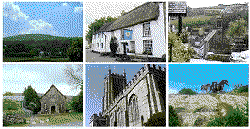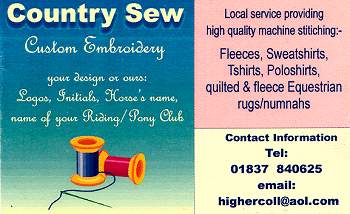Beacon Villages
cosdon.co.uk south-tawton.co.uk south-zeal.co.uk cosdon-beacon.co.uk
Belstone South Tawton South Zeal Sticklepath
Under Cosdon Beacon Dartmoor Devon UK

Archives |
|
Area
Map |
Events
Calendar |
| Area Weather | |
Alezane's
Web |
Photo
Album |
| |
|
|
|
|
News Story 3
| Your Own Web Site ? | |||||||
She approached me to help her to set up the site and it occurred to me that their may be others of you, who would be interested in doing this - either for your own business or just as a hobby. I do not profess to be a professional web site designer and would not want to take business away from those who will set up a web site for your business, for a fee. All I would like to do is give you some idea of how easy (and cheap) it is, to get a web site up and running. It is rather similar to decorating your own home. Anyone can do it - but maybe it takes a trained designer to make it look really good and a professional decorator to make the design a reality. It doesn't hurt, however, to know what is involved, so you have the choice of what to do and who will do it for you. So far, Cherry has chosen a name for her site - the same as her business - "Country Sew". She next had to check, to see if the name was available as a web 'domain name'. Two things are involved here, the name itself and the extension e.g..co.uk , .com, .net , etc. Regarding the extension, a couple of factors influence your choice - cost and marketability. The extension says something about the site's purpose (.com/.co = business, .org = non business, .ac = academic and so on) . and its origin. If you have .com it is international but dearer to register. If you have .co.uk or most other .something.uk , it is cheaper but defines the country of origin. The name should be chosen with care to reflect what people, searching for your product or site using a search engine such as Google, are likely to enter as a search word or phrase. If, like Cherry, you provide personalised embroidery, people searching might enter 'embroidered logos' for their search. This will not automatically find 'Country Sew'. You can add a list of 'key words' as well as the name but a marketing opportunity has been lost. There are many firms on the internet who will sell you a domain name, often competing on price. It is worth bearing in mind that it is best to buy your domain name from the firm with whom you intend to host your site, if you do not want to have to go to the bother of moving your domain to them at a later date or having your registration firm re-direct your visitors to your hosting site (which is supposed to impede your progress up the search engine ratings chart). It is worth noting that those of you with an IP (Internet Provider) account for e-mail and web surfing (e.g. Tesco, Virgin, Tiscali, AOL, etc.) may well already have enough free web space, to put up your hobby web site. Beacon Villages takes about 25MB for its 120 pages, you could comfortably house a ten page site in 5 - 10 MB. Even the meanest IP gives you that! So, Cherry bought her www.country-sew.co.uk domain name for about £7 for two years Think of your web site as being on a series of sheets of paper - pages. When someone logs on to your site they read the first page. It should contain two things - an introduction, saying what your site (business, hobby) is about and a way of navigating - getting to the other pages. All of your other pages must contain navigation features but each of them will be about something different. Very simply, for a business, you want a page (s) for your products and a page (s) about getting them to your customers - price, delivery, how to order, etc. For a simple business or hobby, that's 3 pages. You will be putting your information over using words, numbers and pictures (drawings and photographs). The more products you have (or things to talk about) the more space this takes up and you will want to use up more pages. You can do this by creating sub sections of your original pages. For example, your page 3 (getting your products to the customer) could break down into 3.1 How to order, 3.2 Delivery, 3.3 After Sales, etc. Once you have your site's outline page structure (just like a simple organisation chart) and an idea of what words and graphic content you want on each page, you are ready to have a first stab at putting this on a computer. What you need is a web site building program. You can do this in two ways - either you get your own and do it on your computer or you use a program provided by your hosting company (in with the price of the package). Cherry I could equally well have started this article by saying plan your site first and get it running on your own machine before buying a domain and hosting package (if you wont be using the free IP web space you may already have!). If you go this way, you will need to get your own 'authoring package' on your own computer. You can get these free, from the CDs bundled with various web magazines, you can download them free from the web or you can buy them. If you buy, you can pay between £30 to £800 so you will need to shop around carefully. My advice would be to start with a free package or even a 30 day free trial of a purchase package. It will cost you nothing but your time and if you decide not to carry on, you are no worse off. A further way to get started is to use a web site 'template'. That is a fully working site design with all the navigation between pages already built. All you have to do is customise it - change the name to your site name, the contents to your contents and so on. This is the way my wife, Carol, started her first web site, as a beginner a year ago, and she now runs two sites. With the coming of Broadband to the area in November, a lot of local businesses will have the chance to compete on equal terms with the rest of he country. My two grandchildren (age 9 and 13) both started their own web sites, so it can't be that hard. Mind you, they soon lost interest as well and are more interested in texting on their mobile phones - something that I have no time (or aptitude) for. |
|||||||
 Last month, we featured a friend of mine, Cherry, who had started up a new business, doing personalised embroidery on all manner of articles - sweatshirts, horse rugs, etc. She has now decided to set up her own web site to promote her business and she has plans to link it with another site that helps her to take various logos and other pictorials and digitise them, for use on her machine.
Last month, we featured a friend of mine, Cherry, who had started up a new business, doing personalised embroidery on all manner of articles - sweatshirts, horse rugs, etc. She has now decided to set up her own web site to promote her business and she has plans to link it with another site that helps her to take various logos and other pictorials and digitise them, for use on her machine.  (renewable annually after that) and bought a starter web site hosting package from the same firm for £28 p.a., a total outlay of under £35! She now needs to build her web site. Please believe me, the hardest part is not the technical computer bit, it is knowing what you want and planning this out, first in your head and then on paper.
(renewable annually after that) and bought a starter web site hosting package from the same firm for £28 p.a., a total outlay of under £35! She now needs to build her web site. Please believe me, the hardest part is not the technical computer bit, it is knowing what you want and planning this out, first in your head and then on paper.  started by buying the domain and hosting package first and is now in the process of planning her site. She can therefore use either method.
started by buying the domain and hosting package first and is now in the process of planning her site. She can therefore use either method.